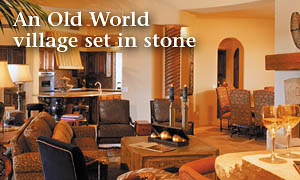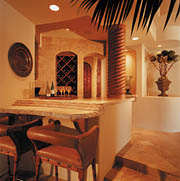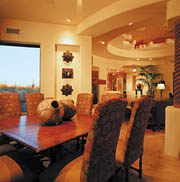

The material was selected for its color and characteristics, according to Chacon, who explained that the design team wanted something "old looking" and "warm" in color. "It was chosen because of its characteristics, which made it look like we took it from an old village, and for its light chocolate color," said the designer.
According to Chacon, selecting the stone was not a difficult process. Initially, Mexican Noce travertine without a tumbled finish was considered, but it was later decided that the tumbled version of this stone was a much better choice. The stone was employed in the exterior courtyard as well as throughout the interior of the home, including the living room, kitchen, dining room, hallway, laundry room and bar wall. In total, 5,000 square feet was used for the interior floors and the courtyard floor in a "castle stone" pattern.
Other stones used to complement the travertine include Jura Beige limestone, which was used for the walls and floor of the master bath in 12- x 12-inch pieces. The same stone was used in slab form for the countertops and tub deck. For other areas of the house, granite, marble and limestone were employed for the countertops, walls and floors. In addition, five slabs of Walnut travertine were used in the fabrication of the three-level bar, with a random chiseled edge detail.
The only major difficulty working with the tumbled stone involved properly setting tiles with random edges, which are generally not as easy to install as regular square pieces. Another difficulty of installation for this particular project dealt with the crowded work environment. "The most difficult aspect of the installation was coordinating the efforts around the other sub-contracting trades, and to work alongside them," said installer Michael Perry of Horizontal Surfaces, Inc.
According to the installer, a modified thin-set method of installation was used for the floors, which is preferred for natural stone floors. White Marble Set from Custom Building Products was the cement-based setting material used for the installation. Also, an impregnating Miracle Sealants 511 sealer was used to protect the stone.
Three individual crews of four installers each worked over a period of five months to finish the project. The entire project took nearly 13 months to complete.

CREDIT BOX:
Private ResidenceScottsdale, AZ
Builder: Pundsack Companies, Co., Scottsdale, AZ
Designer: Est Est, Inc., Scottsdale, AZ
Stone Installer: Horizontal Surfaces, Inc.
Stone Supplier: Arizona Tile, Tempe, AZ
Installation Products: Custom Building Products, Seal Beach, CA; Miracle Sealants, Arcadia, CA